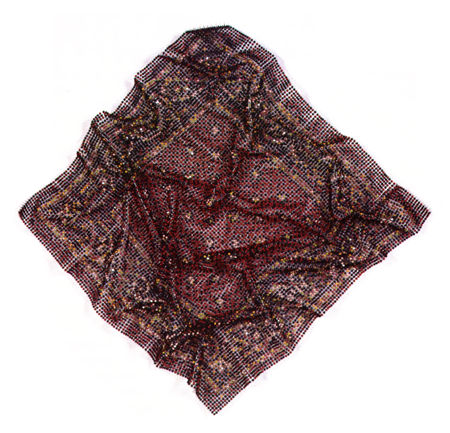at James Graham & Sons Gallery, 1014 Madison Ave, NYC
June 21- August 31, 2001

photo credit: Michel Delsol
New York
James Graham & Sons Gallery
In the 70's, textile work was liberated from its feminine, light art/artisan ghetto and permitted into the art dialoque. Since then, it has been strapped to feminist art discourse. But the social symbolism of textiles is hardly limited to women's oppression. As Tolstov stated in his proto-feminist short story "The Kreutzer Sonata," "Millions of people, generations of slaves, perish at hard labor in factories merely to satisfy women's caprices."
While not all of the works in "Alterations" deal directly with textiles' gender associations, none avoids the painfully comples schism between mass production and handcrafts. Devorah Sperber, in Lie Like a Rug (2000-2001), humorously addresses this twisted relationship by crafting a Persian rug out of 18,000 pen caps pushed into a curving flexible canvas. The rug's pattern, which is clearly seen only through a nearby convex mirror, is a common one, widely mass-produced to become a suburban home decorating favorite. Popular because its acceptably exotic look seems appealingly "original," the factory-mad rug was designed to convey handcraft associations. By remaking it by hand using obviously manufactured materials, Sperber inverts its original connotations. Without the mirror, the colored caps look like pixels commenting on a media-induced consumer mythology that attributes romantic qualitites to mass-produced objects appealing to nostalgia for a pre-industrial age.
Simililary, George Stoll's Untitled (President's heads, shite-pink and black) (2000) produces a sense of discordance between what we pay fore, what we pay with, and what we get. Two festive forms made of silk organza-one black, one pink--dangle from the ceiling, looking like garnishes for a lady's drink. They seem light fun, and precious, but as they turn, the graceful accordion folds reveal the familiar profiles of Lincoln and Washington, as if pennies and quarters were spun so fast that the stately profiles popped of the metal and floated away. Stoll's delicate works contrast the tangible beauty and value produced by intellectual and hand labor with money's abstract, symbolic worth.
The more intimate meanings of handcrafts are touchingly expressed in Donna Sharrett's crocheted memento-mori incorporating dried rose petals, claret-colored glass seed beads, and ash blond synthetic hare. Set against black velvet, this somber piece reads as a poetic, tenderly anachronistic response to death's omnipotence and memory's fragility.
The most compelling treatment of gender is Charles LeDray's Untitled (Sailor) (1993), a doll-size, hand-sewn sailor suit jersey that embodies the contrivances from which masculine identity is constructed. Resembling an outfiltfor an antique boy doll, the garment's delicate appearance does not undermine its masculinity. Like the recent "Uniform: Order and Disorder" show at P.S.1, it demonstrates how manufactured myghologies create identity while obscuring individuality. Tom Fruin's Flag: Alfred E. Smith Housese(Sept./Nov./April) (2001) also speaks to identity, effectively locating illegal street drugs within the context of life stories by linking them through quilting, a medium associated with oral tradition. Fruin sews a quilt out of the pastel-colored drug-baggies found in a particular neighborhood, the housing project in the piece's title, some of which have tiny bits of product still inside. Far removed from Laura Asley, Fruin's found-object quilt creates a tactile sense of intertwined personal histories by tying an "outsider" product, marketing, and consumer together. Like all of the work in "Alterations," Fruin's piece takes an aspect of daily life and cleverly pays homage to its narrative and transformative power by examining its interlocking layers of hypocrisy, beauty, and myth. -Ana Honigman